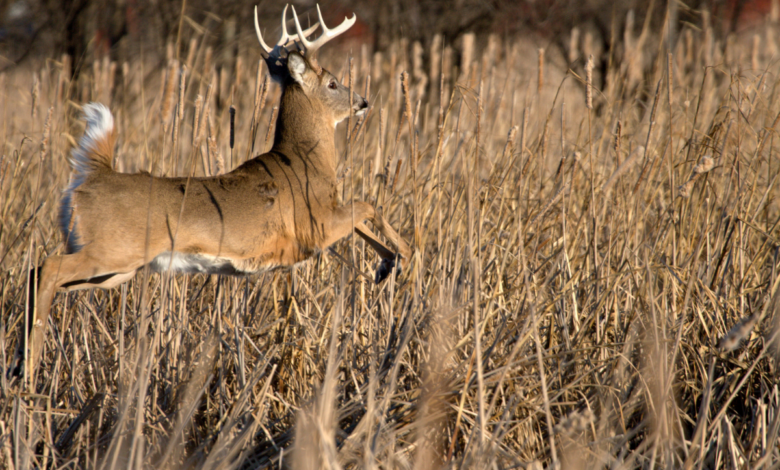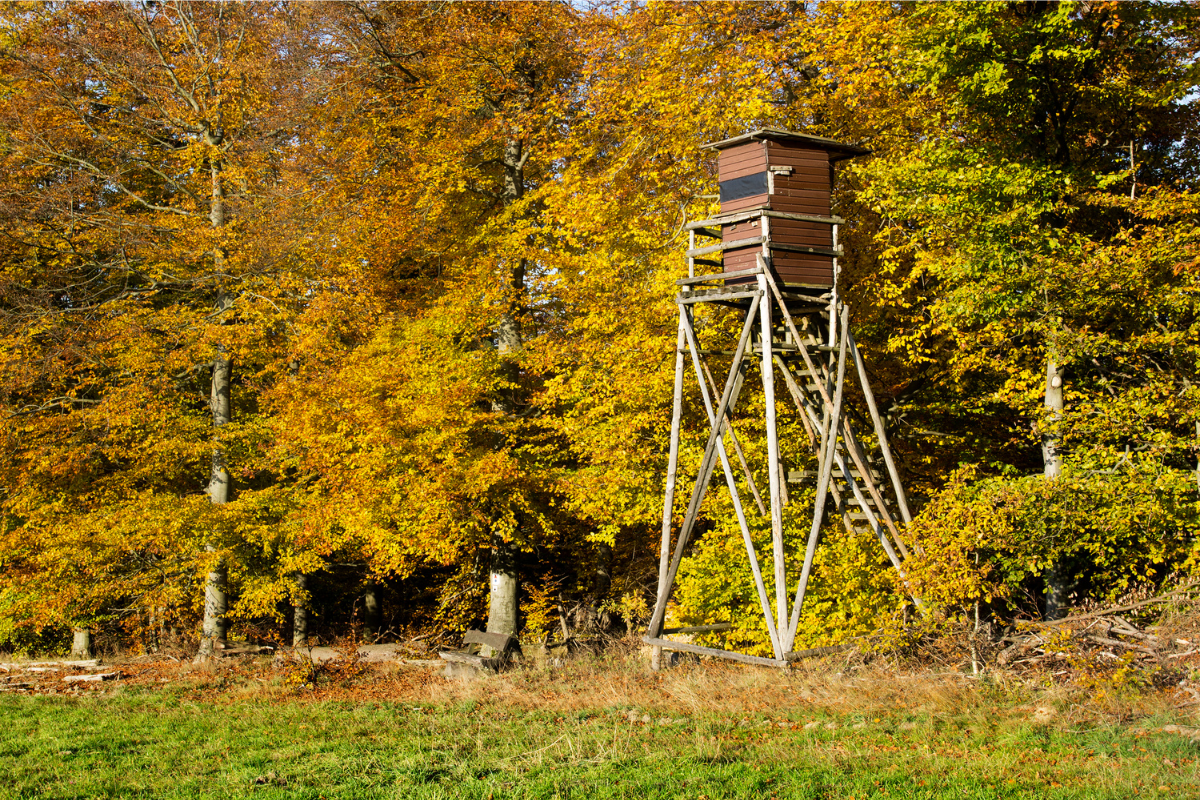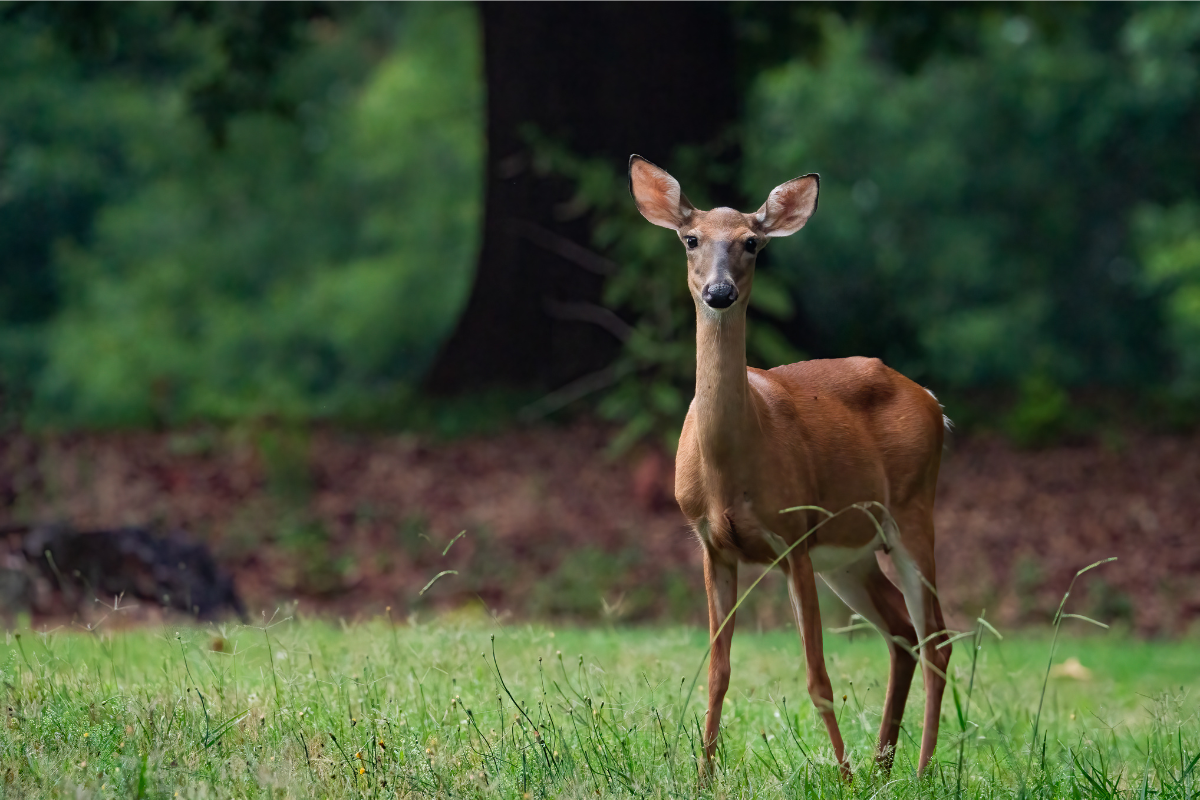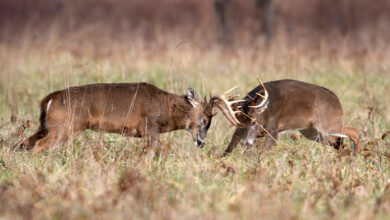12 Deer Hunting Tips and Tricks for Whitetail

Whitetail hunting isn’t only about luck, it’s also about having skill, patience, and knowing the habits of your prey. I’ve been chasing whitetail deer for years, and I’m excited to share some tips that will help you successfully hunt that buck you’ve been dreaming about.
Whether you’re a seasoned hunter or you’re just starting out whitetail hunting, these deer hunting tips on how to hunt whitetail deer will help you up your game and increase your chances of success with white tail deer hunting.
1. Understand Local Rut Phases
The first one of my deer hunting tips and tricks is to understand local rut phases. The rut is prime time for whitetail hunting, but it doesn’t mean everybody is going to have luck during this time. You’ll need to understand how it plays out in your area.
In my experience, the rut typically happens in three phrases – pre-rut, peak rut, and post-rut.
Pre-Rut
During pre-rut, bucks start marking their territory and sparring, which is when you’ll see more rubs and scrapes. Bucks are establishing dominance and marking territory.
During this time, make sure you focus on trails connecting bedding areas to food sources. Bucks are still in their summer feeding patterns, but are getting more active. Look for rubs on trees 2-3 inches in diameter. These are often made by younger, more active bucks. Don’t ignore them – they can lead you to bigger bucks later.
Peak Rut
Peak rut is when the magic happens – bucks are actively chasing does and aren’t as cautious as usual. Post-rut is when the bucks are worn out and tired, and they focus on feeding to regain their strength. Peak rut is ultimately the whitetail hunter’s Super Bowl. Typically, peak rut occurs in mid-November, unlike peak season for mule deer.
During peak rut, don’t be afraid to hunt all day. Some of the biggest bucks are taken in the late morning to mid afternoon when other hunters are out of the woods. You should focus on pinch points and funnels where bucks might chase does.
Post-Rut
As December rolls in, most does have been bred. Bucks are exhausted and are looking to recuperate. They’ll hit high energy food sources hard, like standing corn, brassica plots, or late dropping oak trees.
Once you know which phase you’re in, you can decide which deer hunting tactic is best. During pre-rut, you should focus on the buck sign. In peak rut, be ready for the deer to move around more during the daytime. And during post-rut, look for food sources.
2. Use Effective Ambush Hunting
Ambush hunting is all about letting the deer come to you. It’s all about being patient, and when it’s done right, it’s incredibly effective. First, you’ll need to identify high-traffic areas. You should look for well-used trails, pinch points, or feeding areas. Once you’ve found a promising spot, set up your stand or blind well before the season starts. This will give the deer time to get used to it.
In my experience, the key to successful ambush hunting is minimal disturbance. Make sure you get to your spot early and be ready to sit there for long periods. Trust me, the wait is worth it when that buck finally steps into your view.
Another important aspect of ambush hunting is understanding thermals. In the morning, air usually rises as the sun warms the ground, carrying your scent uphill. In the evening, the pattern reverses. Make sure you position your stand so you can take advantage of these thermal currents, and don’t neglect how powerful water sources can be.
A secluded pond or even a creek crossing can be a major hotspot for deer activity, especially during dry spells or in the early season. When you set up near water, make sure you place your stand downwind of the most likely approach routes.

3. Rotate Your Stands
One of the best pieces of advice I can give you is to rotate your stands. Whitetails are smart, and they’ll pattern you if you’re predictable.
I like to have at least three to four stand locations for each property I hunt. This allows me to rotate based on wind direction, the time of day, and deer movement patterns. It also prevents you from over-hunting in one specific area.
When you rotate your stands, you keep the deer guessing. Plus, it gives heavily hunted areas a chance to “cool off” and return to normal deer activity.
When you plan your stand rotation, you should consider seasonal changes in deer behavior. Early season stands near food sources might not be as effective as the rut approaches. Instead, you can focus on travel paths between the deer’s bedding and feeding areas.
4. Cover Up Your Noise
Whitetails have incredible hearing. One snap of a twig can send them running for the hills. To minimize noise, you should plan your route to your stand carefully. Make sure there aren’t any debris before the rutting season starts.
When you’re moving through the woods, take slow and deliberate steps. I often pause between my steps to listen and observe. In the stand, be mindful of every moment. You can use padding on your seat and platform to muffle sounds and make sure you keep your phone on silent.
Some other ways you can cover up your noise is to invest in noise reducing gear. Modern hunting clothes usually have soft and silent fabrics that won’t rustle as you move. You can also use wax on stand joints and silicon spray on zippers to make things even quieter.
If you’re a bow hunter, make sure your bow is whisper quiet with string silencers and limb dampeners. On dry days, you can carry a small spray bottle around with you to dampen leaves around your stand.
5. Hunt With The Wind
This might be one of the most important deer hunting tips I can give you. Always, always, always hunt with the wind in your favor.
Whitetails have a great sense of smell, so if they catch a whiff of you, game over. Before each hunt, check the wind direction and choose your stand according to it.
Ideally, you want the wind blowing from where you expect the deer to be towards you. This way, your scent is carried from the deer’s approach. Once again, understanding thermal currents will be crucial when hunting with the wind, and don’t forget about crosswinds either.
Sometimes a stand with the wind blowing across your shooting lane can be effective because your scent is carried to the side and not directly into the deer’s path. It’s a good idea to invest in a reliable wind checker, and don’t just rely on the breeze on your face.
6. Mask Your Odor and Utilize Scents
Even with favorable wind, it is crucial to control your scent. You can start with scent-free soaps and detergents, and store your hunting clothes in airtight containers with earth or pine scent wafers.
Before I head out, I spray down with a scent eliminator. You should always use scent as a tool to attract deer, or cover your own. During the rut, buck urine can be a powerful way to attract deer. Doe estrus scent can also bring in curious bucks. Just be careful not to overdo it – less is often more with scents.
I’ve recently started using ozone technology, and it has been such a groundbreaker. I run my clothes and gear through an ozone generator the night before a hunt, and it seems to knock out every last bit of human odor.
When I’m laying down attractant scents, I don’t just drag a scent wick anymore. I create a scent trail that mimics how a deer would naturally move, leading right to my stand. During pre-rut, I’ve had bucks come charging into mock scrapes I’ve made with buck urine – they can’t resist checking out the competition.
Don’t forget about your breath either – I use unscented toothpaste and avoid my morning coffee before climbing into the stand. Trust me, your scent strategy needs to evolve throughout the season. What worked for me in October might send deer running in December when they’re extra wary.

7. Focus on Doe Movement
Where there are does, there will be bucks – especially during the rut. Do your best to learn the patterns of local doe groups, such as where they feed and where they sleep. Understanding doe behavior will put you in the right place when bucks come looking for mates.
In the early season, focus on food sources that attract does. As the rut approaches, look for doe bedding areas. Bucks will be cruising these areas looking for receptive does.
I’ve found that keying in on doe family groups can be a goldmine. These groups usually consist of an adult doe, her fawns from this year, and maybe her daughters from previous years. If you can pattern one group, you’ve essentially patterned multiple deer.
I like to set up observation stands early in the season just to watch doe movement. Pay attention to how they enter and exit fields – they often use the same trails consistently. I’ve had a lot of success during the rut hunting the downwind side of known doe bedding areas.
8. Invest in Good Optics
Another one of the most important whitetail deer hunting tips is to buy a good pair of quality optics. You can’t shoot what you can’t see, and good optics are worth their weight in gold.
A quality pair of binoculars will help you spot whitetail deer at a distance and identify potential shooters. They’re also great for scouting without disturbing an area.
Don’t skimp out on your scope either. A clear, reliable scope can make the difference between a clean kill and a miss, or worse – a wounded deer. I prefer a variable power scope. It gives me the flexibility for both close shots in thick cover and longer shots across fields.
When I’m choosing binoculars, I don’t just focus on magnification. I’ve learned that factors like objective lens size, eye relief, and field of view are equally important. For whitetail hunting, I swear by my 10×42 binos. They give me the perfect balance of magnification and light-gathering ability without being too heavy for all-day use.
I can’t tell you how many times this has saved me during those crucial low-light moments at dawn and dusk.
9. Establish Your Calling
Calling is a game changer, especially during the rut. But like any skill, it will take some practice to get it right.
Start with grunt calls. A series of short grunts can definitely get a buck’s attention, and during the rut, you can try a longer and more aggressive front to mimic a challenger.
Rattling can also be pretty effective. It imitates two bucks fighting over a doe. Start soft and gradually increase the intensity. I’ve had bucks come running in from hundreds of feet away to check out the commotion.
And don’t forget about the bleat calls. A doe bleat can attract both does and bucks. The buck grunt and doe bleat combo can be deadly during the rut.
The last thing for you to do is learn the buck wheeze, which is a sound bucks make when challenging each other. Use the wheeze sparingly, though, and in the right situation. It can bring a dominant buck looking for a fight.
10. Stay Mobile
While stand hunting is my go-to method, sometimes you need to get on the move. If deer aren’t moving or you’re not seeing anything from your stand, don’t be afraid to do some still-hunting. Make sure you move slowly and stop frequently to glass the area ahead of you.
I also like to use a climbing stand when I hunt new areas because it allows me to quickly and quietly set up wherever I find a good sign. Remember, mobility is about adapting to the deer’s patterns. If they change, you need to change with them.
11. Hunt the Funnels
Funnels are natural or man-made features that concentrate deer movement and are gold mines for whitetail hunters. Natural funnels include things like saddles between two ridges, strips of cover between fields, or creek crossings.
Man-made funnels might be lanes cut through thick cover or gaps in fencerows. Identifying these areas and setting up nearby can put you right in the path of traveling deer. This is often how I’ve tagged my biggest bucks.
12. Utilize Trail Cams
Another one of my favorite deer hunting tips is to utilize trail cams. They allow you to pattern deer without constantly disturbing the area.
Make sure you place your cameras on known deer trails, near food sources, or over scrapes. Check them regularly, but be smart about it. I like to check cameras in the middle of the day when deer activity is at its lowest.
Use the intel from your cams to decide when and where you should hunt. They can tell you which bucks are in the area, when they are moving, and what routes they’re using.
Frequently Asked Questions About Whitetail Hunting
What attracts deer the most for hunting?
Food is the biggest attractant for whitetails. In the early season, focus on agricultural crops like soybeans or alfalfa. As the season progresses, look for acorns, especially white oak acorns. In the late season, food plots or standing corn can be hotspots.
What is the best time of day to hunt deer?
The classic answer is dawn and dusk, and for good reason. Whitetails are crepuscular, which means they are most active during these low-light periods. But that doesn’t mean you should discount midday, especially during the rut.
Bucks will be on their feet all hours looking for does. Some of my biggest bucks have been taken between 10am and 2pm. In the late season, afternoon hunts can be productive since deer like to move to feed before nightfall.
What is the best method to hunt deer?
There really isn’t a particular “best” method for hunting deer. It really depends on the terrain, time of year, the weather, and your personal preferences. That being said, stand hunting is probably the most popular and effective method for whitetails.
Tree stands give you a great vantage point and help keep your scent above deer level. Ground blinds can be effective too, especially in areas without suitable trees.
Still hunting, which is slowly walking through the woods, can also be productive, especially in areas with lower deer density, but might be more difficult hunting in the rain. And don’t forget about drives – they can be very effective when done correctly, especially in thick cover.
Final Thoughts
These deer hunting tips will definitely help to improve your odds, but remember, there’s no substitute for time in the field. The more you hunt, the more you’ll learn about deer behavior.
Make sure you always prioritize your safety and ethical hunting practices. You should be comfortable with your weapon and know your limits. A clean and ethical kill should always be the goal.
Lastly, don’t forget to enjoy the experience. There’s something amazing about being out in the woods at dawn, watching the world wake up around you. Whether you tag out or not, these moments are what make hunting special.
So get out there and put these whitetail hunting tips into practice, and good luck this season. Who knows – this could be the year you’ve been dreaming about.




Thanks for sharing and I may experiment a little with some of the calls you suggested.
Awesome Jennifer, thanks for reading!